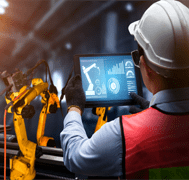Advancements in machine learning and the Internet of Things (IoT) are increasing the presence of AI in manufacturing. Here are five areas where industry leaders need to pay attention.
 Predictive Maintenance
Predictive Maintenance
Instead of being reactive and only fixing something when it breaks, predictive maintenance uses data science and analytics through technology like IoT to estimate when a piece of equipment will fail, so maintenance can be scheduled before failure at the most convenient and cost-effective moment.
While preventative maintenance relies on historical data and averages to try and predict when service will be necessary, predictive maintenance uses real-time data, ensuring the utmost accuracy. As a result, predictive maintenance can reduce breakdowns by 70 per cent and lower maintenance costs by 25 per cent.
Supply Chain Management
Supply chains are becoming more complex and more challenging to manage. Pandemic-related disruptions highlight the need for agility. Integrating AI end-to-end makes supply chains more transparent, enabling better analysis and decision making. AI’s data gathering and processing capabilities make this trend a game changer.
AI in the logistics and supply chain market is predicted to reach 6.5 billion USD by 2023. Surprisingly, supply chain leaders have been slow adapters, with only 4 per cent willing to claim their operations are future ready. Those willing to be aggressive on this front are sure to get ahead of their competitors.
Product Optimization
Product optimization comes from analyzing manufacturing processes and finding places where improvements can be made, which is exactly where AI and machine learning thrives. Analyzing large datasets using sensors and IoT, algorithms learn the complex relationships between the many variables and parameters within the manufacturing process at a scale humans cannot replicate.
However, the robots aren’t ready to replace the humans just yet. Over 40 per cent of manufacturers have added data scientists to their workforce, and another 35 per cent plan to do so within the next five years.
Cybersecurity
As businesses are pouring billions into automation and IoT, cybercriminals are targeting digitally connected industries. During the pandemic, IoT ransomware attacks shot up 700 per cent. The number of connected devices in the manufacturing industry today means cybersecurity cannot be solved with traditional human-based monitoring; we need machines that can protect themselves.
Machine learning and algorithms can detect subtle, abnormal patterns among millions of lines of code. Once detected, security admins can be alerted. Companies will need to stay ahead of this arms race because with each new advancement comes opportunities for cybercriminals to exploit.
Machine Vision
Machine vision facilitates automatic inspection, process control, and robotic guidance using digital sensors protected inside industrial cameras with specialized optics to get images, which computers process. Positioning the inspected items, cameras, and lighting must be exact, often requiring time-consuming manual inspections.
AI can help by automating some of these processes. For example, through machine learning, machine vision technology can be taught how to spot certain characteristics of items, like pattern recognition, and spot errors. The increasing demand for quality inspection and automation is driving the market for machine vision at an expected CAGR of nearly 7 per cent from 2021 to 2028.
We have expertise in IoT device integration with ERP, MRP and MES—from VR/AR to RFID to Active Equipment Monitoring. Contact us to find out how technology can improve your business processes and efficiencies at https://sheaglobal.com.